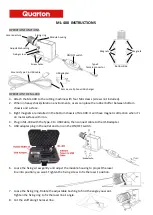
Rev K Jan 2020
Page 2
Chapter 1 Overview
1.2 APT Software Overview
1.2.1 Introduction
As a member of the APT range of controllers, the LTS series stages share many of
the associated software benefits. This includes USB connectivity (allowing multiple
units to be used together on a single PC), fully featured Graphical User Interface
(GUI) panels, and extensive software function libraries for custom application
development.
The APT software suite provides a flexible and powerful PC based control system
both for users of the equipment, and software programmers aiming to automate its
operation.
For users, the APTUser (see Section 1.2.2.) and APTConfig (see Section 1.2.3.)
utilities allow full control of all settings and operating modes enabling complete ‘out-
of-box’ operation without the need to develop any further custom software. Both
utilities are built on top of a sophisticated, multi-threaded ActiveX ‘engine’ (called the
APT server) which provides all of the necessary APT system software services such
as generation of GUI panels, communications handling for multiple USB units, and
logging of all system activity to assist in hardware trouble shooting. It is this APT
server ‘engine’ that is used by software developers to allow the creation of advanced
automated positioning applications very rapidly and with great ease. The APT server
is described in more detail in Section 1.2.4.
Aside
ActiveX®, a Windows®-based, language-independent technology, allows a user
to quickly develop custom applications that automate the control of APT system
hardware units. Development environments supported by ActiveX® technology
include Visual Basic®, LabView™, Borland C++ Builder, Visual C++, Delphi™,
and many others. ActiveX® technology is also supported by .NET development
environments such as Visual Basic.NET and Visual C#.NET.
ActiveX controls are a specific form of ActiveX technology that provide both a user
interface and a programming interface. An ActiveX control is supplied for each
type of APT hardware unit to provide specific controller functionality to the
software developer. See Section 1.2.4. for further details.






































